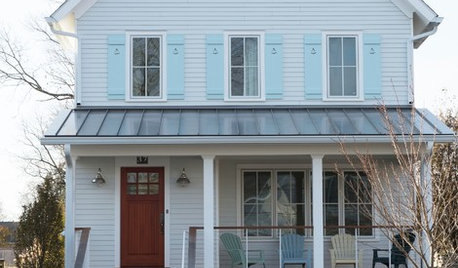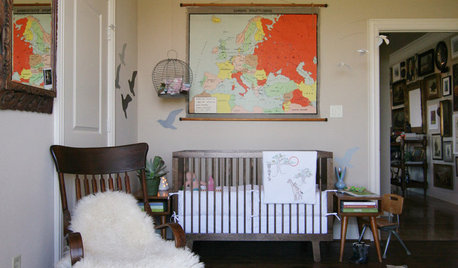First time using Al's Gritty Mix... in an emergency
As a newby who just recently joined Garden Web, I would like to share my experience using what I have learned from Al's Container Soils - Water Movement & Retention threads to address an "emergency." I have a beautiful 8-year-old Clivia miniata "Victorian Peach" that has bloomed three times. Here is a photo of it in the summer of 2008. {{gwi:6374}}
When it began to flower last summer during hot and humid days, the scape never elongated and the bloom got "stuck" in the base of the plant. A few days ago, I noticed that there was crown rot developing at the site of the aborted bloom between the leaves at the base of the plant. I carefully cut off the leaves and the top part of the crown to remove all rot. I treated the cut surface of the crown with a fungicide. The plant has produced five offsets, one of which is three years old and ready to produce blooms of its own. I had promised a friend that when the time was right this spring, I would divide the plant and send him the mature offset. When I realized that the plant was in danger, I decided that I needed to move fast if I was going to be able to save it. Here's a photo of the plant after I cleaned out all the rot. {{gwi:6375}}
Here's a photo of the roots once I removed it from its pot. Note that clivia roots are similar to orchid roots, but very susceptible to rot {{gwi:6376}}
Yesterday I went shopping for the ingredients for Al's gritty mix. From left to right, I purchased 24 quarts of Repti-bark fir bark for $18.99; 24 quarts of NAPA Floor Dry #8822 for $7.99; and 50 pounds of Gran-i-grit grower grit for $7.99. (The bag of grit looks about the same size as the other two bags, so I am guessing it's about 24 quarts.) I also purchased 2.5 pounds of gypsum for $8.95. {{gwi:6377}}
Here are the ingredients before mixing (granite at 6 o'clock): {{gwi:6378}}
I had to use a kitchen colander to screen the Floor Dry. I just rinsed the granite. The fir bark seems a little large, with no fines, so I just used it out of the bag. Here is the final mix: {{gwi:6379}}
I divided the plant with a sharp, sterilized knife to remove the mature offset to send to my friend and removed as much old soil as I could. I also remived any dead roots, but there were only a few. I repotted the crown with its four offsets into a one gallon pot of damp gritty mix. I allowed the roots to rise above the mix a little so I could keep an eye on their health. If any problems develop, I should be able to tell because the roots will start to show rot. This is an idea I got from my clivia "mentor" and it has worked for me in the past. It may not be necessary with gritty mix. Here's how the plant looks now: {{gwi:6380}}
I now have about 17 gallons (2+ cubic feet) of gritty mix left over for my next project, plus two pounds of gypsum. The total cost for this project was about $37, or just over $2 per gallon. It would be much cheaper to use pine bark fines, but none of the garden centers are selling it during winter.
Comments (46)
meyermike_1micha
13 years agolast modified: 9 years agoWowowowowwowowowoa! Fantastic job and I personally am very proud of you for putting your Clivia in this mix as I have done all mine. They LOVE the mix and produce very well!
Your mix also looks very good. It is so encouraging to see how many people I have never met come out and show us how much they have learned over all this time.
Superb!
I will be back with a few of mine starting to bloom in the gritty mix. You are right, once in this mix, you do not have to worry about watching for rotting roots. You could of just stuck them in the mix right up to the green part.:-)
Mike
Ohiofem 6a/5b Southwest Ohio
Original Author13 years agolast modified: 9 years agoThank you for your kind words. Color me tickled pink! As soon as I read about the gritty mix I knew my clivias would love it. I've been growing them for seven years and searching constantly for a faster draining mix. I have quite a collection, but I've been scared to repot them for fear of rot. They're all bursting at the seams. As soon as they finish blooming, they're all going into this mix.
I also want to add that any comments or suggestions about how I might do something differently are also welcome. I am a little nervous about how the fir bark pieces seem so much larger than the other components. I learn so much from trying out something myself. I am hoping my post will also help others who are thinking about taking the plunge.
Related Professionals
New Bedford Landscape Architects & Landscape Designers · Glendora Landscape Architects & Landscape Designers · Wilmington Landscape Contractors · Concord Landscape Contractors · Barrington Landscape Contractors · Kaneohe Landscape Contractors · Las Vegas Landscape Contractors · Little Ferry Landscape Contractors · South Farmingdale Landscape Contractors · Orlando Window Contractors · West Springfield Window Contractors · Chicago Heights Fence Contractors · Fort Worth Fence Contractors · Palmetto Bay Fence Contractors · Fountain Valley Fence Contractorsgreenman28 NorCal 7b/8a
13 years agolast modified: 9 years agoHello, Ohio! ;-)
Great job taking the plunge! I think your post will help others who are teetering
on the side-lines, wanting a better mix but not sure how or where to begin.The Fir Bark is rather large - many times larger than the bark that I use, in fact.
I would consider looking for a more appropriate Bark product as soon as it becomes
available in the garden centers. I've had luck with "Orchid Bark" in fine grade,
but I still screen out the large particles and the very fine bark dust.This type of mix will be perfect for your Avocado, too ;-)
Hey, Mike!
Joshtapla (mid-Michigan, USDA z5b-6a)
13 years agolast modified: 9 years agoYou're a quick study, Amy, and what you relate sounds a lot like Jodi's story. I know you're going to be very pleased, but I'm still anxious to hear your story after your plant recovers from the emergency work. Great job, btw!
The bark is quite large, at least 2-3 times what would be ideal, but it gets you a start until you run across some pine bark you can screen, or until you find a source for fir bark that is more appropriate. The only real issue is, when there is a large difference in particle size, the soil tends to separate. I'll probably be attending a bonsai convention in Louisville in June, so if you don't find any bark, and if you're anywhere near the I-75 or I-65 corridors, I could probably bring you some - if you were willing to meet me on the highway; or, if you aren't too far off the beaten path I'll be traveling I could probably drop it off.
The soil does hold more water than you think, so be careful about over-watering until you get the feel for it. A good way to 'feel your way through' initially, is to stick a wick in the drain hole and only water after the wick feels completely dry right where it exits the pot - use the wick as a 'tell' and to help guard against over-watering.
Hey - I'm excited for you and wish you lots of luck (even though consistent good growing has nothing to do with luck - good growers make their own luck). I tip my hat to you.
{{gwi:2595}}Al
jodik_gw
13 years agolast modified: 9 years agoWow... deja vu! This brings back some memories, Ohiofem... I'm so glad you found the gritty mixes, and were reading up on everything, already!
This is exactly how and why I started using a medium with a larger particulate! I was having terrible rot issues with my Hippeastrum and other tender bulbs... and I didn't want the same thing to happen to my Clivias!
Most of my bulbs are now safely planted in a gritty medium made from ReptiBark, granite chips, perlite, and turface. I haven't had any rot issues lately, at all!
That's a great Clivia with a gorgeous bloom... I'm so glad you were able to save it!
The ReptiBark you have seems a bit larger than the ReptiBark I've got... though I couldn't say why. There's probably a bit of difference between batches at factory level, when it's being bagged... I don't know. I use it right out of the bag, and it's been perfect every time. I wonder if the smaller bags have smaller bark? I've been using small and medium bags from PetsMart or Meijer's, though I can't imagine why that would make a difference.
In any case, I'm sure you'll find a bark product in a better size for other plantings... this is good start, and it certainly won't hurt the Clivia to have larger bark pieces.
Good save... and I'm glad you documented it in photos! That's extremely helpful!
monet_g
13 years agolast modified: 9 years agoMost impressive, Ohio. Clivias are fabulous plants, but they can sometimes be troublesome. One thing I'd like to mention is that you might want to get the open area into a convex cut so that water won't collect and possibly develop rot again.
This is one of mine that received similar treatment last year.
{{gwi:6381}}This how it looks now. (Looks like my bark is a bit too large, too.)
{{gwi:6382}}You're going to love the health of the roots in the gritty mix.
{{gwi:6383}}...and if I may. My Victorian Peach flowering now.
Much different than yours, but the VPs are quite variable. Both are beautiful.
Ah, Al, what a nice offer. You are right that the gritty mix can hold more water than one might think. With the knowledge that you have shared and that fact that plants in this medium are more forgiving of my mistakes, my plant growing experiences are much more successful and pleasurable.
Again, well done. The description with photos is like watching a good movie for me ;-).
GailOhiofem 6a/5b Southwest Ohio
Original Author13 years agolast modified: 9 years agoGail:
Thanks for the reassurance and the gorgeous pictures. Your Victorian Peach is lovely. Mine actually bloomed a little more pale after the first year, but it's never been that light.
I was thinking that the larger bark might not be too much of a problem for my clivias. I can wait until I get smaller bark for other repotting efforts. May I ask how often you water your clivia in the mix with the larger bark?
monet_g
13 years agolast modified: 9 years agoWatering can be tricky because of the environment. I still can't stop doting, but I think I've gotten better. A large pot in winter can go for a week or more. In the summer, again a large pot, outside and hot, I watered every 3 days, but wonder if that was too much.
Some of my clivia plants showed some stress. However, many had been recently shipped from overseas. So, what I'm saying is, that I'm still working it out.
I think the thing to remember is that the gritty mix holds more water than you might think. Further, clivia retain a fair amount of moisture in their roots.
Gailtapla (mid-Michigan, USDA z5b-6a)
13 years agolast modified: 9 years agoThank you very much, Gail. The kind compliments are always greatly appreciated, but what I really homed in on was your mentioning, ".... my plant growing experiences are much more successful and pleasurable." THAT, is the main reason I post, and every time I see someone making that comment, inside I'm saying "YES"!!! ;o)
Great pictures too, guys! Nice thread, Amy.
Al
tapla (mid-Michigan, USDA z5b-6a)
13 years agolast modified: 9 years agoOops! It's Robin's thread - Amy's nowhere to be found; but that doesn't change the fact that the pictures are great ....... & it's still a fun thread! Sorry, Robin! ;o)
Al
Loveplants2 8b Virginia Beach, Virginia
13 years agolast modified: 9 years agoHello Everyone!!!
I just wanted to chime in and say that I checked at Petsmart and they have two different brands of Reptibark...
One was definately larger than the other..(you were right Jodi!!) The smaller sized bark one was the brand .."Zoo Med"
The large bags were the same size fir bark as the smaller bags in this particular brand...Hope this might help!!!
Beautiful pictures Ohiofern and Gail...love the color!!!
Takae care everyone!! : )
Laura in VB
Ohiofem 6a/5b Southwest Ohio
Original Author13 years agolast modified: 9 years agoBe careful about what you purchase. Zoo Med makes Repti-bark, which is labelled 100% fir bark. It also makes a product called Forest Floor something, which is actually cypress mulch. I believe cypress mulch contains a substance that suppresses growth in some plants. Also note that the pine bark fines some garden centers and landscapers in Ohio sell costs about $3.60 for 2 cubic feet, or about 60 quarts. Compare that to $18.99 for 24 quarts of Repti-bark. I wouldn't have bought it if I could have gotten my hands on pine bark in the right size. I also checked out orchid bark at a local garden center. It included hardwood bark, which I believe Al has said would not be good.
Loveplants2 8b Virginia Beach, Virginia
13 years agolast modified: 9 years agoThanks Ohiofern!!!
I agree that the Reptibark is expensive... Definately cheaper to buy the bark fines for $3.60..If you are lucky enough to have that available!!! LOL...
Here in VB ....I'm on the "hunt" for the fir bark or the pine bark fines.... but I do have a few leads...so i will work on them tomorrow..THANKS AL!!!!
Take care everyone!!! : )
Laura in VB
jodik_gw
13 years agolast modified: 9 years agoYes, the manufacturer/packager of Repti-Bark is Zoo-Med. The bags state on the front that they contain 100% fir bark... for use with reptiles. I never use cypress or cedar or any other type of wood products for my plants OR pets. I've always used aspen or pine shavings for puppy/animal bedding, and fir bark for plantings.
I didn't really notice that Repti-Bark came in two different product sizes... I usually go for the medium or small bags, since I don't need to make very large quantities of the gritty medium at one time.
This season, however, I'll probably end up purchasing a larger bag to tide me over until I can get up north to Oak Hill Gardens and grab some larger, less expensive bags of fir bark.
Products like Repti-Bark might cost a little more, but to me it's worth it. I can use it without having to screen out dust and fine particles, and it's available locally. Oak Hill Gardens is a good 3 1/2 hour drive!
I'm really glad everyone is finding what they need to build a better medium! It's much more enjoyable to grow plants when you know you have a much better chance at success!
The Clivia I have are both small... and typical... the orange and yellow flowering types... but they're so much happier in the gritty mix! I probably water more often, but they're in smaller pots of unglazed clay.
The peach variety is really lovely! I wish I had more room to collect more plants, but I'm so packed as it is! I don't think I could fit another Clivia into my apartment!
Ohiofem 6a/5b Southwest Ohio
Original Author13 years agolast modified: 9 years agoDon't get me wrong. I am very grateful for the suggestion from Jodi and others to use Repti-bark. I plan to use all that I bought to repot all my clivias, plus probably my avocado (thank you, Josh!) and some succulents. I think the larger bark size may actually work better for those house plants that suffer when I put them outside for the season and we get deluged with day after day of rain in late spring and early summer. I just want to encourage people who are new to making their own mix like me to read the ingredients before buying the product. It's actually quite an adventure, kind of like a detective hunt. I went to five different stores on my quest for ingredients.
meyermike_1micha
13 years agolast modified: 9 years agoGail!
That flower is so pretty! Remember when you and I use to talk about using the gritty mix when you first started?
You my friend have come such a long way and look at the difference on your plants and the roots.
Such a great job:-)Hello everyone:-) The support here is just amazing and I got to tell you, the roots on my Clivia plants except for the ones exposed to dry air are just so white a clean. One plant has to be righted up since the roots are growing out of the pot.
Here are a couple of mine starting to show a bloom stalk. One even in bark a bit to big being the very variegated one doing very well. You can even grow these plants in just bark, if you don't mind keeping the mix moist more often.
Have a great day ALL:-)
Mike
monet_g
13 years agolast modified: 9 years agoReally nice, Mike.
Great roots. With clivia it is all about the roots.
...and now thanks Al, you and encouraging others, it's clear that it's all about what's going on under the plant that makes the plant perform on the "up side". Gotta love the gritty mix.
Mike, be sure to post pics of the blooms.
Gailjodik_gw
13 years agolast modified: 9 years agoI just wish I had known that the ReptiBark came in different sizes. It never occurred to me that reptiles would or could be housed using larger fir bark pieces. No harm done, but it's a useful piece of information for future reference.
After thoroughly going over the bag from the ReptiBark I have, I can't find a size mentioned on it anywhere, or anything indicating that it comes in other sizes. I'm wondering if perhaps it comes in different sizes only in some areas of the States? As in areas that are warmer and would likely be home to more reptiles as pets? I don't know... I'm at a loss to explain it. I still think it might be simply a batch issue that happened at the packing plant, or something.
In any case, for future reference, we need to check the bag contents before buying to make certain the fir bark is the size we need, or can be screened to give us a majority of product in the size desired.
Locating all the ingredients I needed was, indeed, a treasure hunt! In my area, all the ingredients are located in different stores at different ends of town! It took a while to locate everything.
Mike, those are nice looking Clivia! I like the variegation! Check out those roots! Nice!
jojosplants
13 years agolast modified: 9 years agoHi Everyone,
Love all the photos and info here!I was at pets mart last night, and looked at the ReptiBark.
The largest bag did seem to have some larger pieces in it. I didn't notice anything on the lable that mentioned particle size though.
I was so tempted to grab a bag! :-)May go back and get a small one this weekend for my small indoor plants. And spend some time this week looking for larger bags of fir bark.
JoJo
greenman28 NorCal 7b/8a
13 years agolast modified: 9 years ago"As below, so above,
healthy roots are
what we love!" ;-)Josh
Loveplants2 8b Virginia Beach, Virginia
13 years agolast modified: 9 years agoHey Jodi,
I wanted to say that when i noticed that there were two different brands of Reptibark...the one Brand "Zoo Med" looked consistant in size...from the large bag to the small bag...but the "other brand" was much larger in size...i will check again on the brand name next time i visit PSmart...i just wanted you to know that the size looked the same in the different size bags that were available here...
Hope this helps!!!!
Hope everyone is haveing a great day!!!! : )
Laura in VB
jojosplants
13 years agolast modified: 9 years agoHi Everyone,
Love all the photos and info here!I was at pets mart last night, and looked at the ReptiBark.
The largest bag did seem to have some larger pieces in it. I didn't notice anything on the lable that mentioned particle size though.
I was so tempted to grab a bag! :-)May go back and get a small one this weekend for my small indoor plants. And spend some time this week looking for larger bags of fir bark.
JoJo
jodik_gw
13 years agolast modified: 9 years agoThis is the bag ReptiBark from ZooMed comes in... and you can also see the Manna Pro poultry grit granite chip bag to the left...
This is how the fir bark looks in medium form...
Here's one of my Hippeastrum bulbs planted in it...
Zoomed's ReptiBark is the only brand of reptile bedding our PetsMart carries, though it does come in three different package sizes... 4 dry quarts, 10 dry quarts, and a larger bag that I've never purchased. The small pet section of our local Meijer's only carries the ZooMed ReptiBark in the 4 quart size.
I was under the impression that ReptiBark was actually ZooMed's own brand name... and anything else would be called simply reptile bark or bedding. I could be wrong, though... since our local stores only carry the one brand.
Next time I'm at PetsMart I'll take a closer look at the reptile bedding, to check particle size. From what I can see, the small and medium bags both contain the same size particles of fir bark, perfect for medium use straight out of the bag.
Unfortunately, nothing else in our area even comes close to what I'm looking for... I've been everywhere, searched through countless garden centers, checking every mulch bag... I've asked everyone, and gotten some of the most blank looks I've ever seen. "What the heck are pine bark fines", I'm asked when I pose the question... and people can't imagine what I'd be using it for. When I tell them, they point to the piles of bagged potting soils... I just say, "thanks, but no thanks"...
Sometime this spring I'll be heading north to visit my kids... and we'll make a stop at Oak Hill Gardens. They carry pine bark fines in bulk... or at least, in larger bags for a smaller price than the ReptiBark.
JoJo, I'd say go ahead and grab a small bag... it's perfect for mixing up small batches! I love the stuff!
meyermike_1micha
13 years agolast modified: 9 years agoHI everyone!
Jojo, I am with Jodi on this too!
I know exactly what you are saying about the "looks" you get when you ask for anything but the bagged mixes for your plants, other than "orchids"..lol
I actually had to teach a nursery and HD worker how to make some gritty mix, and none of them had ever heard of turface, let alone plain "fir bark", unadulterated with no other amendments in the bag such as charcoal for orchids.
Heck, unless you own a farm or have chickens, most have never heard of using "grit", let alone using it for plant mixes... All never knew it was just "crushed granite".
Have a great day all. Spring is almost here. I can't wait to put my plants out and use a hose to mass spray all of them whenever I want!
By the way Jodi, your mix looks way beautiful and so does the looks of that plant just starting out! No wonder your plants do soooo well! I can't wait to see the flowers.
Hugs from Mom to her friends here as you know who you all are, she says.
Ps...Don't you just LOVE the color your mix turns once you water it in? It turns so clean, colorful, and bright in appearence.
Mike
Ohiofem 6a/5b Southwest Ohio
Original Author13 years agolast modified: 9 years agoWell, it's only been a week, and I am so pleased with the gritty mix that I've repotted six more clivias. These are younger plants that haven't bloomed yet that have not been looking very happy in their water-retaining soils. (My mature clivias seem to be draining well because they are almost completely pot bound like the one in the photo at the beginning of this post.) I thought I should wait until the weather would allow me to put them outdoors where they'll start growing again, but the photos and stories the rest of you have shared convinced me that benefits of moving them into a better mix would outweigh the risks of waiting for better weather.
Now I have another question for those of you who know about clivias. A friend just sent me some seeds, and I am wondering if I can try starting them in the gritty mix? Clivia seeds are big, so they're not likely to get washed out in such a heavy mix. They also take a long time to germinate and are very prone to fungus and root rot. What do you think?
meyermike_1micha
13 years agolast modified: 9 years agoHi Ohio!
Well, you certainly have the right mix to start seeds with, considering it will be the best choose for avoiding "fungus" and "root rot".
Now, I have never sprouted a seed before, but have been contemplating it. I would use only the gritty mix for this and probably grab some ideas from a couple of links I will provide for you.
I am so happy to see your plants are loving this mix as ours are. Fantastic! Please let us know when your seeds sprout and keep us updated on your clivia progress. I will make sure this thread doesn't get lost by posting updates on mine too:-)
http://forums2.gardenweb.com/forums/load/houseplt/msg0817403119360.html
http://forums.gardenweb.com/forums/load/clivia/msg0413555120106.html
Have a great night All
Mike
Here is a link that might be useful: Starting clivia seeds by me thread.
Jessicasgrowincitrus
13 years agolast modified: 9 years agoThanks for all the great photos Everyone! I am new to container planting and am trying to learn all I can about citrus in containers. Mike suggested that I check out this thread to get a better idea (and a visual) of the ingredients required for the gritty mix. I can hardly wait for tomorrow to go get all the things needed to re pot my ailing Meyer Lemon!(Yup- the rookie planted her first lemon tree in Miracle Grow Potting soil... Ooops) Thanks so much! This was super helpful! Just what I needed!
monet_g
13 years agolast modified: 9 years agoOhio,
I wouldn't use the gritty mix for clivia seed starting. When starting these seeds, they're typically just placed on top of the medium and the root has to make it's own path into it. The gritty mix is just too "tight". I, personally, like coconut husk chips.
{{gwi:6389}}Others use perlite or spagnum moss. Anything that's airy and moisture retentive should do.
Gailmeyermike_1micha
13 years agolast modified: 9 years agoGail! ! That is just wonderful!
What kind of seeds are you sprouting? What colors? You just may have a buyer here since I am always looking for a color that I do not have.
When will it stop, this buying of plants that is? lol
Those seeds look so ripe and ready to sprout. Do you keep them covered too?
Speaking of seeds sprouting, time to check up on my avocado seed..Looking good.Thanks Gail
Hey Jessica! Look at that, a newbie:-))))))) Welcome aboard. I can't wait for you to start seeing results in using a much better mix. I can't wait for you to meet so many good people here. I can't wait for you to find and see the ingredients you get. I can't wait to see you post and ask questions more often.
Welcome Jessica. It is a pleasure to be of service to you:-)
Mike
monet_g
13 years agolast modified: 9 years agoHi Mike,
That photo was taken last summer when I brought in quite a few seeds from South Africa, Australia and New Zealand. I did cover the seeds loosley with a baggie.I had them in the warmth, on the deck. They were doing nicely until it came late summer when the squirrels/critters seriously started their seed gathering. Unfortunately, I only lost a few.
Gailjodik_gw
13 years agolast modified: 9 years agoFirst... I'm not sure what exact mixture of ingredients you've seen or had experience with to call the gritty mix "tight", but I don't find the gritty mix "too tight" for seed starting, at all... in fact, I'd recommend it for seed starting.
Never underestimate the strength, power, and survival instinct of a seed and its root! If a sprouting seed can push through the densest of clay, or grow in some of the impossible places they do manage to grow, pushing through the gritty mix will be like pushing through a bowl of rice! The trick, I would think, is to keep the seed moist and warm while it's germinating.
The various ingredients for the gritty mediums can be measured and mixed in any relation/proportion to suit the individual environment or purpose. There's no exact mixture set in stone... just the basic recipes, which most folks follow. As long as you are understanding of the concept of the mix, and you have knowledge of how it works and why you're using it... the sky is the limit. The mix can be tweaked any way you like.
I am continuously tweaking my gritty mix for various purposes. If I want more moisture retention, I use more turface... if I want a lighter mix, I use more fir bark and perlite and a little less granite chips and turface. It all depends upon the purpose of the mix, the plant type, or the placement of that container. I adjust my care of that container to suit the medium and the plant.
Welcome aboard, Jessica! You've just entered the Gritty Zone! ;-)
Begin your adventure at the link I've included below... in case Mike hasn't already pointed the way... it explains in layman's terms everything you need to know about growing fantastically healthy container plants! It blows old gardening wives's tales right out of the water, and gives us the basic science we need to thoroughly enjoy our growing experiences!
Once you understand the concept of growing in a larger particled, gritty medium... once you grasp the how and the why of it all... you'll probably do what we all did... we ran out to locate the ingredients we needed to give it a try!
You'll never be at a loss for support! The group we have is comprised of wonderful, generous people, all willing to share what we've learned and lend a helping hand in case you have questions. There's a ton of great information on the grittier mediums and growing in them right here in the Container Gardening Forum... do a little reading, and if you need further help, please don't hesitate to ask! Again... welcome, Jessica! :-)
Mike... you're too kind. I'm not certain how many of my bulbs will gift us with blooms this spring... I did neglect them in the previous seasons due to my work load, so I'm not holding my breath! However, most will be going out to live in the new greenhouse very soon, and they'll enjoy that environment all summer. That should help them recover from my neglect, and set buds for the following bloom season!
Here is a link that might be useful: Container Soils - Water Movement & Retention 12
Ohiofem 6a/5b Southwest Ohio
Original Author13 years agolast modified: 9 years agoIt's interesting that Jodi just linked to our favorite thread on container mixes. At almost the same moment over there, Al (tapla) was explaining why he doesn't like using coir or coconut husk chips as more than a small part of his mix. Pop on over and read it if you're interested. My own experiences with coir were not good, so I avoid it. Although I am a "newby" to Garden Web, I am not new to growing clivia from seed. I've grown about a dozen clivias from seed to blooming over the past seven years and currently have about three dozen seedlings between six and 18 months old growing under lights. I have had the most success sprouting them in damp long fiber sphagnum moss, but once they've produced a second leaf, I have moved them to my favorite potting mix, which happens to be made up of large particles and is 45% composted pine bark. (Now I know why I've liked that mix so much.) Now, I suspect there would be an even better mix for the two to three years it takes for clivias to get to blooming size. I'm leaning toward 511, but am intrigued by the gritty mix. The roots on clivia seedlings literally seem to climb out of any mix I've used, and I regularly have to reinsert them. In their natural habitat they sprout and grow on the leaf litter on the forest floor, and sometimes even in the litter between a tree branch and the trunk. The "heaviness" of the gritty mix, as well as its looseness might actually be an advantage. The next time I have a bunch of seeds available, I think I'll try an experiment comparing the two mixes at the seedling stage. If I do, I'll be sure to keep a photo record to share here.
jodik_gw
13 years agolast modified: 9 years agoI, too, have had very poor results using coco coir products. I was told by several people to use cocopeat for my bulbs... what a disaster!
Coco coir products not only retain oodles more water than is necessary or wanted, they also contain harmful salts. Some companies pre-rinse their product before bagging and selling, but I've found that even the pre-rinsed coir needs further soaking and rinsing before use... not that I recommend using it! I don't!
Funny thing is... I'm not an amateur gardener! I should know better than to take unproven advice at face value! But... trusting soul that I was, I potted most of my collection in the cocopeat... and lost several bulbs to root rot. The cocopeat also developed quite a bit of the most colorful molds I've ever seen in my life! It simply retained way too much moisture for long periods of time... and talk about compacting! Full pots degraded to half full pots fairly fast!
When I un-potted the bulbs I managed to save, I noticed a lot of varying degrees of discoloration in the layers of cocopeat... not to mention a ton of dead and rotting roots.
To make a long story short, I'm eternally grateful to have found the excellent information provided in that linked article, and I'm now growing everything in a rendition of the Gritty Mix.
As for seed starting... I'm no Clivia expert, but I would think that warmth and keeping the seed moist during germination are important for success. I use a small heat mat for seed starting and for rooting cuttings... bottom heat definitely helps promote root growth. I'd be very interested to learn how Clivia seeds do in the Gritty Mix. Be sure to keep us posted, Ohiofem!
tapla (mid-Michigan, USDA z5b-6a)
13 years agolast modified: 9 years agoIf you don't have an aversion to terra cotta, I would use terra cotta bulb pans and the gritty mix. I'm sure they'll do fine. Stick a wick in until the plant is well-established - just to be sure no perched water lingers at the pot bottom.
Al
Ohiofem 6a/5b Southwest Ohio
Original Author13 years agolast modified: 9 years agoThanks, Al! Sounds like a good idea.
Ruby Chang
12 years agolast modified: 9 years agoSo, I have a couple of question...they might be kind of dumb...but I am just curious! I can't wait to try the Gritty Mix, soiless mix? So crazy but brilliant!
I really am just curious about the silly questions below. Someone please elucidate?
For a very very beginner such as me, I thought that plants NEED (?) to be in "soil" to live. And soil is organic+some little bits of stone and stuff(from looking at "normal" soil in garden). When we replace the main organic constituents with inorganic things like granite and turface, does that not allow roots to have nutrients uptake from the "soil"--which normally provides these things? Is that why it is important to fertilize? Because soil-less mix itself does not provide nutrients? (or maybe it does, I don't have a clue).
Ruby
tapla (mid-Michigan, USDA z5b-6a)
12 years agolast modified: 9 years agoSome people draw a distinction between types of soil, thinking it's improper to call a mixture of peat and perlite a soil, or that because something doesn't come from the top layer of the earth (mineral soil) it's not really a soil, but if plants grow and have their roots secured in it, it's a soil. Actually, the gritty mix is much closer to a mineral based soil than anything most readers are/were used to growing in, simply because it's has a 2/3 mineral fraction as opposed to something like Miracle-Gro soil with perhaps a 2" mineral (perlite) fraction, the remainder being organic components.
Anyway ...... in our gardens & beds, ie in mineral soils, we rely on soil organisms to break down minerals and organic components alike, into elemental forms plants can utilize. Because of the bulk density of mineral soils and fine particle size, attachment sites for nutrients are numerous. Container media, with their relatively low bulk density and low CEC, don't hold nutrients well. We can't depend on the breaking down of the organic fraction of the soil to supply nearly enough nutrition for plants to grow normally. That's partly because of the low CEC and partly because of how slowly the nutrients locked in hydrocarbon chains become available.
If soils DID break down fast enough to supply nutritional requirements, it would quickly destroy the soil's structure.
Which point leads me to the idea that container soils (or media if you like) are more about the structure than about any nutrition they might supply. Some gardeners try to build the nutrition into the soil, which usually comes at the expense of either the soils structure or structural stability. Near perfect nutritional supplementation can be had via synthetic soluble fertilizers. Using them, you can concentrate on only the soils structure, while you shoulder the responsibility for the plant's nutritional needs. With fertilizers like Foliage-Pro 9-3-6, you can be sure you're supplying all the essential nutrients in the right ratio, and you can also be sure of how much and when those nutrients are available, the 'when' part being immediately. You don't have to guess at when the fluctuating populations of soil organisms might make enough of this or that nutrient available so there are no deficiencies.
Growing well in containers doesn't get any easier than when you use a well-aerated soil and soluble synthetic fertilizers.
Al
Ruby Chang
12 years agolast modified: 9 years agoThank you Al for answering my questions! They make a lot of sense!
I just have to make sure that I do use fertilizers regularly when I use the Gritty mix (since I am not adding any fertilizer in the mix)...
tapla (mid-Michigan, USDA z5b-6a)
12 years agolast modified: 9 years agoI was hoping you'd be able to make sense of what I offered. ;-) Yes, fertilize regularly when using the gritty mix. I heartily recommend Foliage-Pro 9-3-6 in combination with it. You'll be well pleased.
Al
charleslou23
12 years agolast modified: 9 years agoso this napa floor dry can be substitute for screened turface or gypsum??
tapla (mid-Michigan, USDA z5b-6a)
12 years agolast modified: 9 years agoThe #8822 is roughly a substitute for Turface. It holds more water than Turface, so to make a soil with the equivalent of the original gritty mix, you'd want to cut back a little on the DE and increase the grit commensurately, while keeping the bark fraction at 1/3 or less.
The Gypsum is used as a Ca source in applications where your fertilizer does not contain Ca. Usually, if there is no Ca, there is no Mg, either. If that is true, please use Epsom salts at low doses as a Mg source. When you get the ingredients together, your fertilizer selected, and are ready to make the soil - stop back and someone will walk you through it. It sounds much more complicated than it is - a monkey could do it. ;-)
Al
tapla (mid-Michigan, USDA z5b-6a)
8 years agoIt's fun to look through these old threads, even if only to see who's come & gone & who's still out there plugging away. I'm glad you're still around, Robin. I hope all's well.
Al


















Ohiofem 6a/5b Southwest OhioOriginal Author